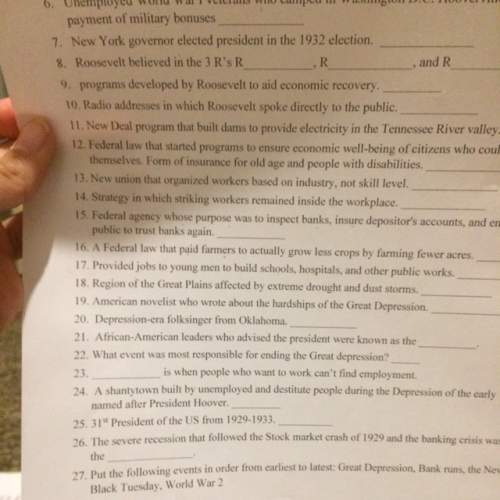
History, 04.11.2020 01:00 jessezarate4513
ANSWER ALL PARTS OR YOU WILL BE REPORTED!! Question 1 (1 point)
Which describes the major cause of the French and Indian War?
Question 1 options:
arguments about the prices Native Americans were paid for the furs they trapped for the British
Disagreements between the French and British over land claims and the fur trade
disagreements between the French and the natives over how to use the land and who owns the land
arguments about the rights of natives in French North America
Question 2 (1 point)
French settlers in North America were mostly located in Canada and the Midwest.
Question 2 options:
True
False
Question 3 (1 point)
What was the main source of contention leading up to the French and Indian War?
Question 3 options:
The desire to rid the territory under dispute of all Native Americans
The desire to raise taxes to pay off war debts
The hope that colonists would not rise up against Britain
The desire to control more land for controlling trade with the Native Americans
Question 4 (1 point)
Tensions rose between the British and French over control of this area...
Question 4 options:
Ohio River Valley
St. Lawrence River
Mississippi River
Missouri River
Question 5 (1 point)
Which European country had better relations with the Native Americans?
Question 5 options:
England
Spanish
French
Question 6 (1 point)
The British North America colonies were more heavily populated than French North America.
Question 6 options:
True
False
Question 7 (1 point)
The fall of these two cities marked the defeat of the French in North America.
Question 7 options:
Pittsburgh and Philadelphia
St Lawrence and Ontario
Quebec and Montreal
Quebec and Ontario
Question 8 (1 point)
Who won the French and Indian War?
Question 8 options:
French and their Native American allies
Spain and Europe
British and their American colonies
Russia
Question 9 (1 point)
What were two major outcomes of the winning of the French and Indian War, by the British, that would be troubling for the British colonists?
Question 9 options:
Destruction of beaver lands and famine due to destruction of crops
Taxes to pay for the high war debt and the Treaty of 1763 banning the moving into western lands
High taxes to pay the French for their lands, and the destruction of their Native American Allies
Question 10 (1 point)
To pay off war debts, the British taxed the colonists heavily.
Question 10 options:
True
False
Question 11 (1 point)
Which problem did Britain face at the end of the French and Indian War?
Question 11 options:
dividing western lands into new colonies
finding colonists who were willing to settle west of the Appalachian Mountains
establishing laws for the colonists who moved west
keeping colonists out of the Native American lands west of the Appalachian Mountains
Question 12 (1 point)
After the war the British passed this resolution forbidding colonists from settling west of the Appalachians?
Question 12 options:
Proclamation of 1775
Proclamation of 1763
Quebec Act of 1774
Lord Dunmore's Proclamation
Question 13 (4 points)
Please match the word(s) to the correct definition.
Question 13 options:
resolution passed by the British that prevented the colonists from moving any further west than the current boundary of the colonies at that time. Created to keep the peace between the colonies and the Native Americans.
The agreement signed between the French and the English that ended the Seven Years War and the French & Indian War.
War with a confederacy of Native Americans due to the lack of conciliatory relations between the British and the native peoples following the French & Indian War.
Built and used by George Washington and the remaining surviving British colonial forces in the summer of 1754; an early battle site of the French & Indian War
Non professional citizen soldiers. Citizens of a town or community called upon to defend their community and families
A stream or river that flows into a larger river
Was the European War which the French & Indian War was part of; the colonial part lasted from 1754 to 1763.
A plan to unite the colonies so they would work together. Ben Franklin's cartoon was used to encourage colonial unity.
1.
Militia
2.
Tributary
3.
Albany Pan of Union
4.
The Seven Years War
5.
The Treaty of Paris 1763
6.
Proclamation of 1763
7.
Pontiac's Rebellion
8.
Fort Necessity

Answers: 3


Another question on History

History, 21.06.2019 22:30
What was the significance of john hancock's signature on the declaration of independence?
Answers: 1

History, 22.06.2019 02:30
Approximately how many americans, from both the north and the south, were killed in battle during the civil war?
Answers: 1

History, 22.06.2019 06:30
Decide whether each statement is true of the indian national congress, the all muslim league, or both
Answers: 3

You know the right answer?
ANSWER ALL PARTS OR YOU WILL BE REPORTED!! Question 1 (1 point)
Which describes the major cause of...
Questions

English, 10.03.2021 14:20

Mathematics, 10.03.2021 14:20




Biology, 10.03.2021 14:20

Mathematics, 10.03.2021 14:20


Geography, 10.03.2021 14:20

Arts, 10.03.2021 14:20

Business, 10.03.2021 14:20

Mathematics, 10.03.2021 14:20


Mathematics, 10.03.2021 14:20

World Languages, 10.03.2021 14:20



Mathematics, 10.03.2021 14:20


Mathematics, 10.03.2021 14:20




